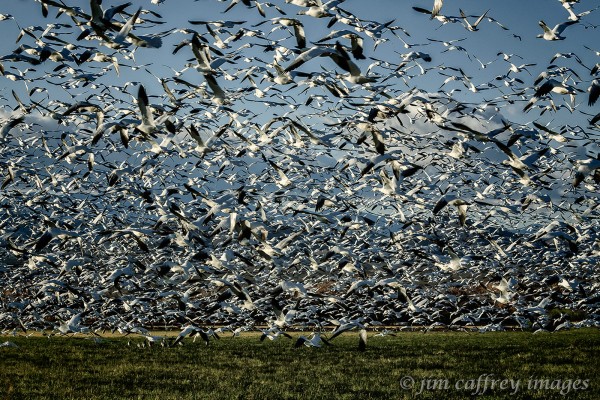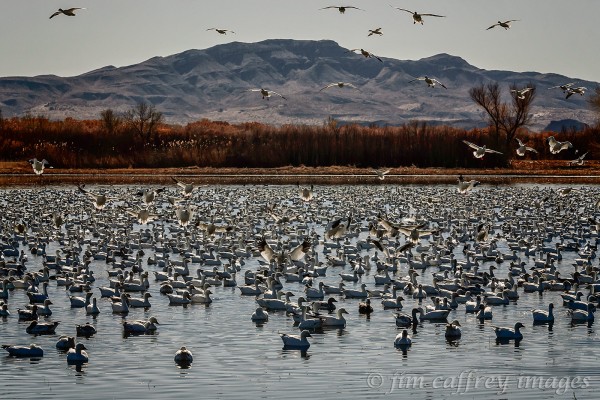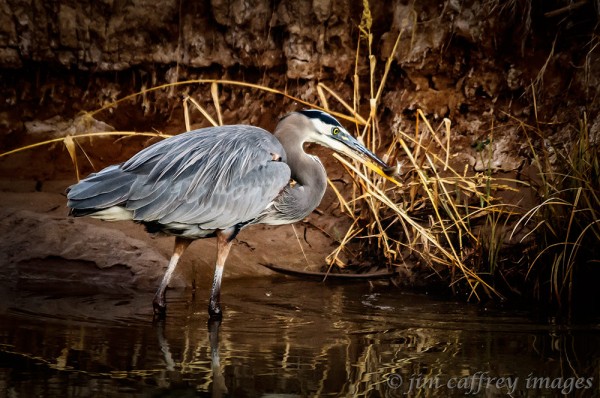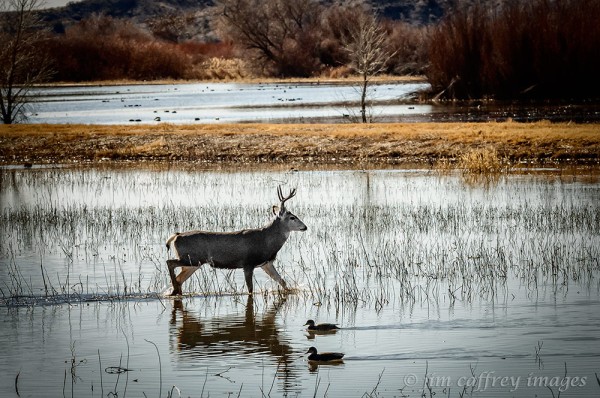Bosque del Apache (A Wider View)
I love my Nikkor 80-400mm lens. On a crop sensor camera like my Nikon D300, I can get the effective reach of a much more expensive 600mm lens–albeit with a stop less light. The 80-400/D300 is my lens/camera combination of choice for photographing wildlife; I rarely use my full frame cameras and wide angle lenses while I’m at Bosque del Apache–at least not while photographing the birds. But, in a deliberate attempt to step out of my box, I have lately been making some wider angle photographs of birds, and I have been pleasantly surprised by the results.
My choice of the longer lens and crop sensor camera is driven by that combination’s ability to get in close and isolate the birds. By stepping back a little and capturing the wider view, I am trading the up close and personal frame for the more inclusive approach, which, I think, makes a more informative image. It puts the action in context.
Of course, this doesn’t mean that I will stop photographing these birds in an intimate context, the wider view is just a different way of approaching the subject, of telling the story.
If you were to go through this blog’s archives and read all the posts about Bosque del Apache, I doubt you would find very many, if any, of these kinds of photographs. So, it is my intention to give you a better overall idea of the scope of the experience.
One of my favorite things about a trip to the refuge is standing near a large flock of geese when they suddenly, in unison, explode into flight. The first image is my attempt to convey that feeling of synchronized confusion that accompanies these abrupt incidents. The geese will also land as a flock, but they are more relaxed in their approach so a few may land at one time, followed by a few more, until they have all touched down.
The Sandhill Cranes, on the other hand generally take off and land in pairs or small groups of two or three. Cranes are monogamous and will keep the same mate until one of them dies. They also move from one place to another in pairs or as an extended family group.

A group of Sandhill Cranes wade in the icy waters while two of their brethren take to the sky in search of breakfast.
Before I began photographing them, I never paid much attention to the habits of birds, but the more I watch them, the more interested I have become in their habits and their lives. Some of these habits can be very useful to a photographer. For instance, when they lean forward with their gaze fixed, it means that take off is imminent, so an informed photographer can be ready when the action begins.
Cranes are gangly creatures. When they approach a landing, they look like marionettes dangling from a string. Their long, spindly legs are improbable supports for their frames and their activities. But there is a certain majestic aplomb and zen-like intensity with which they carry out these movements that negates the clumsiness.
Over the years I have developed a kind of schedule for photographing at the Bosque. I usually get to the pond early, just before sunrise and then spend several hours with the cranes as they awaken and fly off to the fields for the day. Afterwards, I drive around the tour loops in the refuge looking for anything that may catch my eye. This is usually when I catch a heron hunting for his breakfast. I realize that this image is a departure from the subject of this article, but this really is the best way to tell the story about the herons. They do nest in groups at night, but their daytime existence is a solitary one. They wade through the shallows looking for a meal, and then move on in search of the next one.
It’s also during these drives around the refuge that I come across scenes like this: hundreds of geese floating placidly in a pond, drowsing, or grooming themselves. Then suddenly and without warning they explode in a cacophony of sound and motion.
Of course, there are other kinds of wildlife besides birds to be found at the refuge. bobcats, coyotes, mountain lions, javelinas, and many others make Bosque del Apache their home. As we were driving toward the exit we came across this young mule deer buck calmly strolling through one of the ponds along the connector road. The two mallards swimming in the opposite direction seemed un-fazed, but stayed on their side of the road.
Bosque del Apache is located about twenty miles south of Socorro, New Mexico along the Rio Grande. I would highly recommend it as a stop on your next visit to New Mexico. If you are a photographer, and you want to isolate the birds, a long telephoto (at least 400mm) is recommend, but as this entry makes clear (I hope), you can make some great images with a shorter lens as well. The best time of year to visit if you want to see the cranes and geese is November through February, but the refuge is open year round and many of the birds and other wildlife make Bosque del Apache their home year-round.













Fantastic post Jim. The beauty and diversity of this area are overwhelming. I’ve never seen anything like it and am glad you shared. I find the sweeping panoramic views of waterfowl to be quite stunning and a very refreshing perspective. Given a choice between a perfect portrait and one of these shots (the 3 species of geese at rest is great) to hang in my den, I’d choose the latter, hands down!
LikeLike
January 20, 2015 at 2:14 pm
Thanks Nick. It really is an amazing place. I’ve been thinking about printing the image of the geese at rest as a large canvas. Your comment has sealed the decision.
LikeLike
January 20, 2015 at 2:44 pm
Your photography is stunning— amazing images! 🙂
LikeLike
January 20, 2015 at 2:43 pm
Thank you Laura.
LikeLike
January 21, 2015 at 8:59 am
Like them all but the heron is my favourite since, while i see them all the time, two today, i never see them close up. Thanks.
LikeLike
January 20, 2015 at 6:06 pm
Herons are usually elusive in the wild, but at Bosque del Apache, they are much more relaxed; it’s easier to get close to them. I think they realize they are in a protected area.
LikeLiked by 1 person
January 21, 2015 at 9:02 am
🙂 i can’t get much closer than 100m before they’re off! And since I’m usually cycling at the time and armed only with a phone or pocket zoom there’s little chance of getting a clear shot. I must try and hide and sneak up close one day!
LikeLike
January 21, 2015 at 9:05 am
A very interesting post Jim, I really like the wider view. The close-ups are fabulous but the wider view puts the birds in their habitat. Superb pictures.
LikeLike
January 20, 2015 at 10:10 pm
Thanks Adrian. Sometimes it’s easy to get trapped in a certain mindset when photographing a subject. I’m happy that I backed off, I’m pretty pleased with the results.
LikeLike
January 21, 2015 at 9:06 am
I love these photos. I tried to get a photo of a Buck all season with no luck.
LikeLike
January 20, 2015 at 10:30 pm
I know this amazing place.I visit it 15 years ago visiting my daughter who lives in New Mexico
LikeLike
January 21, 2015 at 4:23 am
I love Bosque del Apache! The wide angle capture of the birds is fantastic. One can really get a sense and feel for being there in their world and experiencing the relationship of them with their habitat. Thanks for sharing.
LikeLike
January 21, 2015 at 4:33 pm
Thanks.
LikeLike
January 22, 2015 at 10:00 am
That first shot is stunning, Jim, really evokes visceral memories of what I love about a good winter day at the Bosque.
LikeLike
January 26, 2015 at 11:01 pm
Thanks Jackson.
LikeLike
January 28, 2015 at 12:33 pm